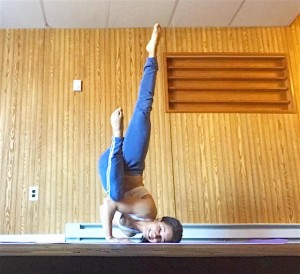 Two months ago, my life with dystonia ‘got flipped turned upside down’ and i’ve been on a rollercoaster ride of recovery from it ever since. Seemingly overnight, my plush California King-sized bed transformed into the terrifying setting for violent contortions that wiped me out for much of the next day. Accompanying this sudden change, the sights that normally inspired me as a writer and the sounds that stirred the composer in me suddenly felt like they were assaulting my brain, like sleet pelting on the bare skin. A prisoner in my own disobedient body, I have been desperately seeking a road to recovery when my eyes cannot see clearly.
Two months ago, my life with dystonia ‘got flipped turned upside down’ and i’ve been on a rollercoaster ride of recovery from it ever since. Seemingly overnight, my plush California King-sized bed transformed into the terrifying setting for violent contortions that wiped me out for much of the next day. Accompanying this sudden change, the sights that normally inspired me as a writer and the sounds that stirred the composer in me suddenly felt like they were assaulting my brain, like sleet pelting on the bare skin. A prisoner in my own disobedient body, I have been desperately seeking a road to recovery when my eyes cannot see clearly.
Drowning in Sensory Overwhelm
It was an overwhelming accumulation of stimulating sights and sounds that had triggered my relapse in the first place. On the Friday before this latest dystonic storm, the fluorescent lights of my neurologist’s building and stimulating tests of neurological function predictably caused my brain and muscles to stutter and stumble. Three days later, a gynecological exam put my nervous system on even higher alert. And the very next day after that exam, I had a triple play of cardiac tests–promising to funk up my heart rate and blood pressure further–at a hospital outfitted with some of my biggest dystonia triggers: fluorescent lights, brash and repetitive sounds, and the blur of constant movement.
My primary care physician had ordered a series of cardiac tests to see if the ongoing palpitations, tightness and pain in my chest were merely due to the muscle contractions of dystonia or if they signified potential compromises in my heart health. I have a family history of cardiovascular disease, and here at age 41, I hadn’t had my own heart assessed in almost ten years. As I also have the diagnosis of antiphospholipid antibody syndrome–an autoimmune condition that affects blood clotting and can significantly increase the risk for early heart attack and stroke–I figured it wouldn’t hurt to have a baseline read that was more recent.
I knew that tackling an exercise stress test was a bit risky. The blind zones of my neurological system were in the early stages of being reconnected with the aid of Dr. Joaquin Farias’s neuroplasticity training for dystonia. Disengaged muscles from dormant brain circuits were just starting to come back online, leading to a moderate increase in tremors and spasm.
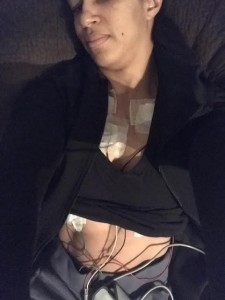 Otherwise, it seemed like it should be no big deal for me to just walk for several minutes on a treadmill. I was in decent physical condition, thanks to daily yoga and semi-regular walks. Yet even in more stable times, twisting spasms could, seemingly out of nowhere, cause my legs to collapse, sweeping me off my feet. Some days seemed safe for walks, while others definitely were not.
Otherwise, it seemed like it should be no big deal for me to just walk for several minutes on a treadmill. I was in decent physical condition, thanks to daily yoga and semi-regular walks. Yet even in more stable times, twisting spasms could, seemingly out of nowhere, cause my legs to collapse, sweeping me off my feet. Some days seemed safe for walks, while others definitely were not.
Another concern I had about the test was the fact that my blood pressure would be taken throughout. About a year and a half ago, I’d come to the realization that cinching blood pressure cuffs triggered dystonic activity more often than not, particularly when I was standing. Walking while getting my blood pressure taken was certainly an iffy situation to put myself in, but I let the technician know the threat beforehand.
Long story shorter, taking my blood pressure did in fact initiate muscle pulling episodes. Determined to get the test over and done with, however, I walked the treadmill for a good five minutes or so before my neck pulled hard to the left and my legs dragged south–just as my blood pressure was once again being taken. My husband and the technician helped me off the exercise machine, and a wheelchair was commandeered for me.
I then was rolled back up to the main cardiology department to get a battery-operated portable device with electrodes strapped to the front of my upper body to get a measure and record of my heart activity for the next 24 hours. Once the Holter monitor was secured tightly with tape, i was able to be rolled out of the hospital, muscles jerking and spasming continually.
Once free of the triggers that abounded in the hospital, I was able to get a little more stable once again. But by the time my husband was driving me back to the hospital the next day to drop off the Holter monitor, I was in severe distress. Intense spasms spread from my chest down to my abdomen, making it increasingly difficult to breathe, especially when contractions forced my tongue out of my mouth and my throat to constrict. As the nurse removed the Holter monitor, she expressed deep concern with my current state and suggested we head down to the emergency room.
I wound up at the emergency room for approximately seven hours. Two separate infusions of a medication frequently used to calm a dystonic storm only provided short time relief. After my neurologist was contacted, I was given two more powerful medications that would stabilize me enough to leave the hospital. My husband and I headed home frazzled and fatigued, unprepared for the days and weeks to come.
Radical Self Care for Rest and Recovery
There are dystonic storms–continuous series of intense episodes of involuntary muscle contraction and contortion that affect most of the body–that need acute medical attention, and there are storms that you are just forced to endure. It took weeks of adjusting doses and substituting medications before I was able to one again experience extended periods of relief from dystonic storm during the day. Unfortunately, my nights–which had previously evolved into a fairly reliable respite from spasm and pain–suddenly inverted with daytime muscle activity, and greatly amplified my movements during and in between abbreviated periods of sleep.
I began waking up at least one or twice a night with violent, Exorcist-like muscle contortions. My neck and back forcibly bent way beyond comfortable range of motion; my arms and legs alternately flexed and extended, causing my feet and hands to get stuck in cockeyed and painful positions; and my body would sidewind like a serpent, trapping my limbs underneath me. Even after taking breakthrough medication, these storms could last up to an hour and a half, wiping me out physically and leaving me mentally drained for much of the day.
Both my body and brain were overstimulated and traumatized by the dystonic storms. An expert in dystonia wisely advised me to dramatically reduce sensory stimulation for a while and to give myself at least a month of true rest and recovery. I had instinctively known that I needed to practice ultra-radical self care instead of trying to plow through the chaos and pain like I normally would. So, the gentle, yet firm reminder to be extremely tender and loving to myself was exactly what I needed to hear.
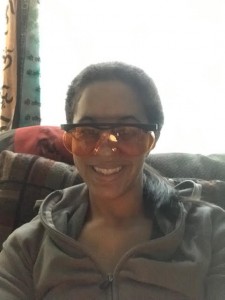 Since the hours of nighttime activity also involved the bones of the face and head, I woke up to debilitating headaches and crippling migraines that forced me to spend my mornings in bed in the complete dark. My brain could no longer tolerate the artificial lights of digital screens, nor the natural light outdoors. So, during the day, I have had to wear my goofy, orange-tinted, blue-light-blocking glasses to help filter the abrasive light. Busy sounds were completing overwhelming, particularly when listened to through headphones. I couldn’t even listen to my beloved music without developing a headache.
Since the hours of nighttime activity also involved the bones of the face and head, I woke up to debilitating headaches and crippling migraines that forced me to spend my mornings in bed in the complete dark. My brain could no longer tolerate the artificial lights of digital screens, nor the natural light outdoors. So, during the day, I have had to wear my goofy, orange-tinted, blue-light-blocking glasses to help filter the abrasive light. Busy sounds were completing overwhelming, particularly when listened to through headphones. I couldn’t even listen to my beloved music without developing a headache.
A Writer Without Her Words
My beloved words eluded me, and I found it impossible most days to even continue my practice of daily journaling. Occasionally I could squeeze out a list of gratitude or jot down memories of my increasingly vivid dreams. Poetic threads encapsulating the physical torment I was enduring would sometimes spill out of me in barely intelligible fragments. A song fragment whose melody I forgot almost immediately. Attempting to read during the day quickly fatigued both my eyes and brain. Both were too overwhelmed by the constant battle with my muscles to do much more than rest and binge-watch Netflix shows that weren’t too visually taxing and didn’t require much, if any, mental processing.
Not surprisingly, I quickly grew bored. Even when I couldn’t walk unassisted or stand for long, I made sure to at least move my body through supported yoga transitions on the bed or couch. When I could stand, I washed dishes. I did my oramandibular dystonia exercises. I hummed, gently practiced vocal warm-ups and softly chanted mantras, feeling the healing vibrations resonate deeply inside me. Finally, I reached out to my friends on Facebook for podcast and audiobook recommendations.
Thich Nhat Hanh’s guide to practice mindfulness in everyday life, Peace is Every Step, lifted my spirits and offered me the hope of baby steps. I strengthened the mind-body connection by listening to Joe Dispenza’s Evolve Your Brain and his conscious-expanding meditations from You are the Placebo. And when I had trouble sleeping, listening to the British narrator croon the childhood classic The Lion, The Witch and The Wardrobe soothed me greatly.
I listened to at least an hour of guided meditations every morning from my bed. The body awareness practices reacquainted me with my physical form in a compassionate manner that helped give me some semblance of control, further reminding me of my capacity to heal. I found solidarity and hope through podcasts by those living vibrant lives with chronic illness. And I stoked the flame of artistic inspiration with the Magic Lessons with Elizabeth Gilbert podcast; every day, I was enlivened by a different episode on creative recovery. It’s no exaggeration to credit audiobooks and podcasts for saving me sanity during this extended recovery period.
The Road to Sensory Recovery: The Art Of Healing
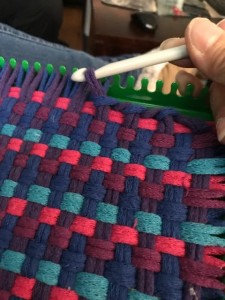 My mind and my ears were positively engaged by these audio sources, but my hands still itched to do something. I was surprised by a persistent pull to the visual arts and tactile crafts. I knew that anything requiring too much eye-hand coordination and manual dexterity would threaten my on-edge nervous system, but I sensed that just enough would do wonders for my spirits.
My mind and my ears were positively engaged by these audio sources, but my hands still itched to do something. I was surprised by a persistent pull to the visual arts and tactile crafts. I knew that anything requiring too much eye-hand coordination and manual dexterity would threaten my on-edge nervous system, but I sensed that just enough would do wonders for my spirits.
When I received the loom potholder kit, I realized I hadn’t done anything remotely like weaving since I was in middle school. But I liked the idea of creating a pattern from the brightly colored cottoned loops. I wove the loops over and under, then under and over each other, across the metal loom. Using child-level motor control helped me to slow down and focus the mind. The meditative effect of has been especially helpful during times when I have excess, restless energy and am fighting the urge to do something “more substantive” that would unnecessarily tax my system.
After a week or so of potholder weaving, I decided to open the giant, goodie jar of arts and crafts materials I’d also ordered. March is the month of family birthdays–my mom, brother and young nephew. Unable to leave the house to buy cards, I decided I would try my hand at making some simple birthday cards of my own. I had made mixed media cards for family in the past, and they had been quite a hit. It took me a few days to finish the cards. I was physically and mentally once completed, but I had accomplished something I knew I couldn’t even have done the week–much less, the previous three weeks–before.
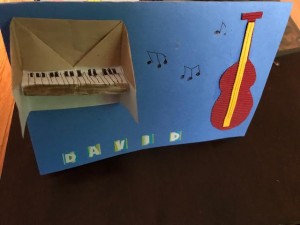 I also experimented with string art, origami and other crafts during this time. With poor eye-hand coordination and a brain going haywire, I unsurprisingly made many missteps and had to restart my projects multiple times. When I went off track, I relied on my intuition and ability to quickly improvise to keep moving forward. While I was occasionally tempted to give in to the frustration and fatigue of working with my shaking hands, I finally said to myself, What if I gave up the idea of perfection, and instead concentrated on the delight of playing my hands? So that’s just what I did.
I also experimented with string art, origami and other crafts during this time. With poor eye-hand coordination and a brain going haywire, I unsurprisingly made many missteps and had to restart my projects multiple times. When I went off track, I relied on my intuition and ability to quickly improvise to keep moving forward. While I was occasionally tempted to give in to the frustration and fatigue of working with my shaking hands, I finally said to myself, What if I gave up the idea of perfection, and instead concentrated on the delight of playing my hands? So that’s just what I did.
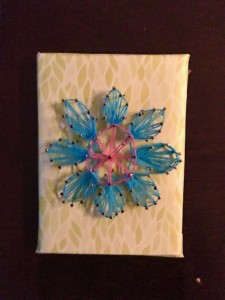
With my other senses deprived in ways they had never really been before, I was finding new ways to express myself. These different ways of making art were not only healing to my body, mind and spirit; they were also giving me new eyes to see who I truly was and am, beyond the titles and what I do. I realize now I am so much more than I ever gave myself credit for being.
The Road to Recovery Illumines Ahead When My Eyes Can See Clearly
After that, some days were good, other days were rough, and a few days were downright great. My nights were still consistently exhausting until a couple weeks later. Once my system adjusted to adding a new medication to the regimen, I experienced a handful of restful nights without episodes over the course of the week.
My husband and I were even able to start taking short walks around our condo complex’s parking lots. Just feeling the fresh air upon my face enlivened my spirit to keep on keeping on. Even with new setbacks cropping up every few days, I knew that I was getting stronger overall–and that gave me hope.
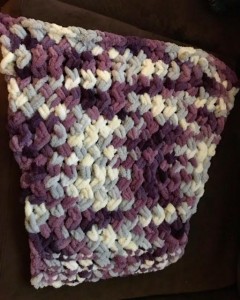
Last week–week 8–I found myself able to sit at the laptop for an hour at a time without triggering complete neurological chaos. There were even days when I didn’t need to wear my blue-blocking light glasses the entire time I was out of the bed. I finally finished my first ever knitting project…about that, I’ll just say that it was uniquely me–perfectly imperfect. I was also inspired to work on a new fiction story. And I started writing this blog post.
One day, my best friend came over with her 2-year-old son. She encouraged me to softly sing songs with her, and we did a simple, yet soothing craft project together. She reminded me just how powerful it is to have strong social support, how healing it is to have friend for life who has always been–and will always be–in your corner.
For the first time in two months, I was able to practice yoga on the mat without a couch or wall to help hold me up; though I was trembling, I made it through my whole practice. I also finally was able to listen to music over headphones; I found a new, favorite artist, who had my boogying on the sofa. My husband and I also went out on my first nature walk outside the complex grounds. Though my body was struggling to hold me upright by the end of the trail, I was thrilled to have gotten a real taste of nature again.
I know I’m not out of the woods yet. I still need to figure out how to consistently sleep through the night without violent episodes waking both me and my husband. I have more medication adjustments I need to make, and there are always growing pains during that acclimating process.
But–and this is a huge but–i can finally see the light at the end of the tunnel.
 I have a myriad of healing tools at my disposal and an amazing support team to help get me through this transition back to a new normal. I say new normal because the patterns of my dystonia movements at present are markedly different from what they were prior to the storm. I’ll have to approach them with a fresh perspective and gently tweaked habits. I also say new normal because I am committing myself to staying the course with a whole spectrum of restorative practices that support my healing, including all types of art, different meditation and deep breathing practices, and the amazing, brain remapping exercises I learned from my January workshop with Dr. Farias and through his new online platform.
I have a myriad of healing tools at my disposal and an amazing support team to help get me through this transition back to a new normal. I say new normal because the patterns of my dystonia movements at present are markedly different from what they were prior to the storm. I’ll have to approach them with a fresh perspective and gently tweaked habits. I also say new normal because I am committing myself to staying the course with a whole spectrum of restorative practices that support my healing, including all types of art, different meditation and deep breathing practices, and the amazing, brain remapping exercises I learned from my January workshop with Dr. Farias and through his new online platform.
I say new normal because before this storm, I had resigned myself to a ‘decent enough’ level of existence that I recently realized wasn’t as great as I had deluded myself into believing. I can see clearly now that there’s a stage of health that far surpasses anything I’ve experienced in my nine years of living with dystonia. A level of freedom and vitality that allows me to truly live life to the fullest, to fulfilling my biggest dreams and deepest desires. With plenty of hard work and play, I pray can eventually reach that light and soak in all the adventure and joy that the world has to offer me.
Wow…how scary. I have had some of these same symptoms with my sight as well but didn’t realize the connection. The “crazy headaches” I used to call them, where I would wake up and have terrible pain, assuming my neck was to blame.. I still don’t know, but I haven’t had one in awhile..Where do you get such glasses? I hope you are doing well